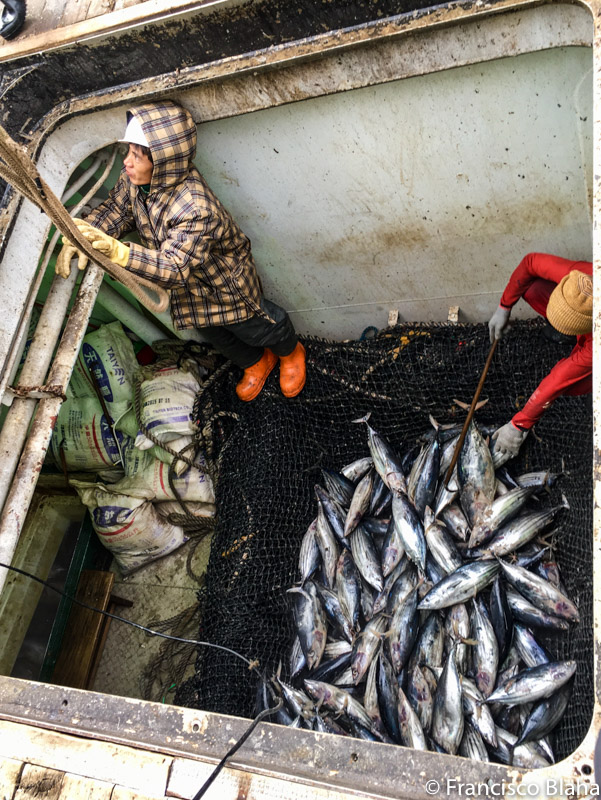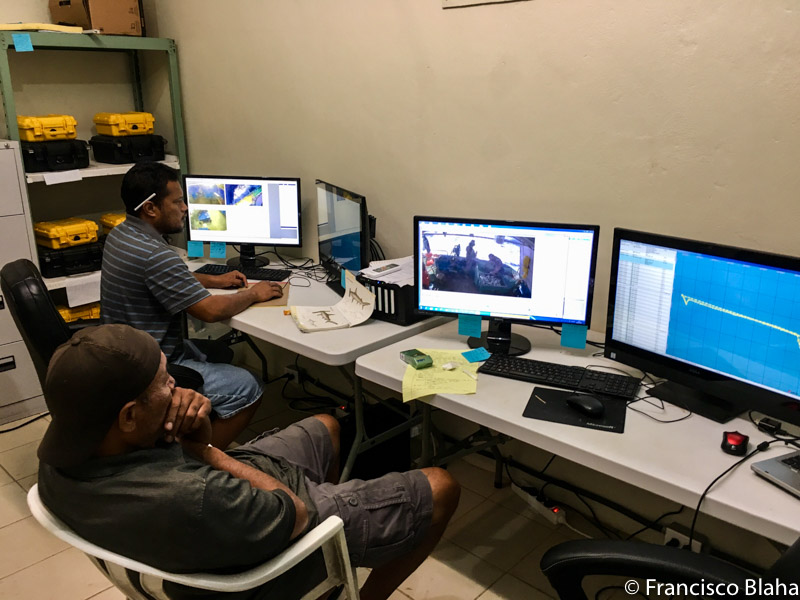I’m always struggling to find time to 1) publish posts, but 2) choosing what to post about, since there quite a lot in my backburner. But I’m finishing my 2nd input of 4 weeks as a OFA here in Majuro, so I decided to write about what I do in this job since it touches many areas of what I normally write, and more importantly I’m working with people that are at forefront of sustainability, the fight against IUU, fisheries data capture, observers safety, while at the same time being victims of sea level rise, the constant remnants of the nuclear past and being catalogued as a tax heaven. And for them is not just discussions in social media… for them is real every day life.
Let's start by saying that I been to a couple of tax heavens… and I can tell you that Majuro does not look like one of them, but let us focus on fisheries…
I wrote in the past about Majuro being the front of Pacific tuna fisheries since is the busiest transhipment port in the region, forty tuna transshipments in Port Majuro during November increased the overall number for the year to 434. This is, however, down from 2016, when 561 transshipments were recorded. Last year, Majuro averaged over 46 transshipments per month.
The highest number of purse seiners in Majuro during November were Taiwanese, with 12 visits. RMI and Chinese flagged vessels were second with seven each. FSM, US, Papua New Guinea and Solomon Islands flagged purse seine vessels contributed to the total.
. Once the fish leaves here is gone for good… so we need to do quite a lot of work with a small team.
As I explained here, I’m here paid by my taxes to the NZ government with the aim to be a trainer the officers and an advisor to MIMRA in general and to my friend (and boss) Sam in particular, and also to Glen that is the big boss here.
I have a work plan with some agreed activities that I follow, so I explain my work based on parts of the plan and the people I’m working with.
One of the big thematic areas is Technical Inputs and capacity building and it does follow with some activities, here are some of the ones I work this time:
Review and provide technical input into technical documentation
As most countries this days, RMI has a IUU NPOA, yet the feeling I always have with this documents is that they are “made to be read by others”, and not applied by the beneficiaries and it should be the opposite. Furthermore, I look at these big documents with 2 frames in mind, one says: “separate what is nice from what is necessary” and the other says: “don't let the perfect get on the way of the good”. So I’m slow progressing a review from a “bottom up” approach, taking in consideration the capacities to deliver, and not only the expected results.
Design and Implement an agreed Oceanic Division training plan
This is the part I like the most. We divide this one, on formal and informal training settings and mentoring by going on boards the vessels and working on finding inconsistencies, explaining the potential tricks to be played, looking at the vessel tracks during fishing operations, so the officers can better recognice them when on VMS and pointing out best practices by the vessels in full compliance.
Prepare and support a vessels’ inspection plan
While we had all the legal powers and the rest sorted, and the was a routine… a formalised “plan” setting out the processes to follow during the inspection framework, wasn't available. So we got on and did one.
The plan is an operational document consistent with the national, sub regional, regional obligations, but we also included some of the latest information on the “real” issues quantified in the region. The sources for the framework are:
- RMI Fisheries Licensing conditions
- FFA Harmonised Minimum Terms and Conditions (HMTC)
- VDS/VMS monitoring requirements.
- WCPFC CMMs and Port State Measures
- 2014 National Plan of Action (NPOA)
- 2016 FFA Evaluation of the Regional FFA MCS Framework
- 2017 FAO PSMA Strategy documents
- 2016 FFA. Towards the Quantification of IUU Fishing in the Pacific Islands Region.
- EU Catch Certification Scheme
Not coming strictly from an enforcement background, but more from practical perspective, I’m happy to take a “fresher” approach by using a lot of visual elements like the decision trees to follow when doing intelligence analysis of arriving vessels (see above) and tabulated SOPs, but as well focus not only on the legal side of fish but on the real numbers getting off the vessels.
Some of the activities finish overlapping, for example: Facilitate the integrated use of new Apps and technologies and Support MIMRA to implement effective regional anti IUU initiatives such PSM and CDS.
I love planning tools, mechanisms and incorporating the opportunities of technology into the challenges of work and at the same time, I’m very involved in PSMA and CDS via FAO and FFA. And my “vision” in these areas are totally complementary so it does not make any sense to work them separately.
So I been working with Ron (a truly gifted IT and programming specialist here in MIMRA) in the development of “Port Entry App” which is loaded at the vessels agents’ computers that communicates directly with the MIMRA’s IMS.
So from January 2018 all actions for port entry clearance are to be made via a “Port Entry App”, ideally I would love to have the “port entry request” triggered exclusively from the PNA FIMS eForms as the way to assure that is being used, but we are not there yet…
I any case, the request gets loaded into the system under a unique identification in order to be processed by Compliances Officer. Then procedural intelligence analysis (following the decision tree) are used for the determination of port entry authorization based on assessing the vessels trip information based on information available to the Compliance officers through FFA RIMF and iFIMS. This info check includes among others: FFA VoI, risk index and VMS track, FIMS Licensing for the areas fished, eForms information (when available) and eObs (when available). These information sources provide the required intelligence, which along the compliance risk identification related to the type of vessel will determine the scope and depth of the inspection when the vessel arrives.
The arrival is then approved in the port arrival system, which communicates the approval back to the agent and the boarding is scheduled and the boarding logistics set up. In the case of various arriving on the same day, the order of boarding is established in accordance with the FFA Compliance Index (1st green vessels, then yellow, then red).
The boarding party will bring on with them the details of any investigation they want to pursue on the vessels and follow the SOP. Only after clearance by the boarding and inspection team the “Port Use” is authorised and coded.
Anyway... long story short… the ultimate vision for Majuro is to a fishing port that is paperless, interconnected and uploading directly into national and regional databases, ready for an eCDS.
A further big thematic area to keep me busy is Institutional Support. Under this, I been working on this trip on facilitating the “development of a Competent Authority (CA)” in terms of Seafood Safety as a precondition to gain access to the EU Market has been long term but never really tackled ambition of RMI. And this is no small task, the EU obliges compliance to its own requirements, and thus requires the 3rd country to prove that it operates a control structure applicable to its seafood exports that are equivalent to those existing in an EU member country, meaning than RMI has to prove that has seafood safety systems and controls equivalent to those of Germany for example.
Of course we cannot tackle this alone, and in an interesting synergy, FFA is moving ahead with Regional Support Unit for CA, which is a concept I developed for them back in 2014, and they are keen to test here.
At the same time, and as part of another activity where I "provide advice to MIMRA staff attending WCPFC", we been measuring the potential impact of the FFA – Japan PSM proposal that has just been incorporated as a CMM. Operationally we are already doing more than the PSM CMM will request us to do, but we also see regionally beneficial outcomes, as it standardised the minimal requirements for all transhipment countries, hence cutting off the chance for the fleets to cherry pick ports.
Finally I been working with my wantok Bernard on the "Development of a Standardised SOP for the operations of the Observer program" here in RMI, furthermore, I was asked to come to the graduation ceremony of the latest course provided with the CMI, and say something “motivational”… I just repeated something I wrote many times before.
Most of the colleagues I respect and value in this job, either have been observers themselves or have spent time at sea doing observer type work. Observers are the unsung cornerstones of our industry. Below you see Bernard, the EM section, and the debriefing "room" at the back of the office for the obserbers that just came back. Total respect for this guys.
And there is plenty of other stuff beyond the work plan itself, things like a MoU to deal with the transhipment authorisation under section 7 of the EU CCS that I’m developing, or some work with ER and EM tools, because basically I'm here to help, end of story
So yes… this is part of what I do for work here… and as I don't really need a car here, the rest of the little time left I’m cycling everywhere, checking the tides to go for long swims and running in the morning… and of course enjoying some of the cheapest and nicest sashimi in the world.









